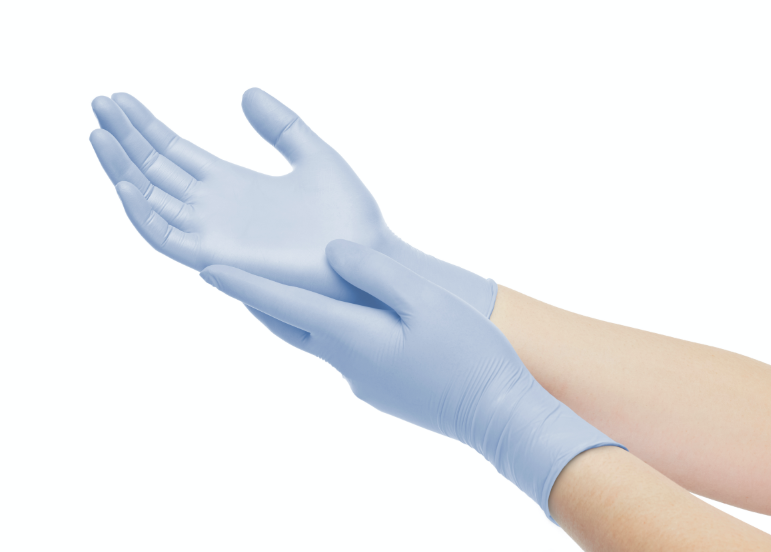lic. rat. med. Jerzy A. Kozłowski
Single-use gloves Single-use gloves provide protection to the skin of the hands against microorganisms, physiological fluids, and exposure to potentially hazardous factors that medical personnel may encounter. Single-use gloves are also used in non-hospital settings, including industry, food processing, cosmetology, and hygiene practices. How do latex, nitrile, and vinyl gloves differ? Which solution is better for whom?
Protective gloves — parameters that matter
The materials used to make gloves must be hydrophobic to prevent cell adhesion. Most chemical substances are diluted in water, and the hydrophobic surface of the glove prevents these substances from sticking to the glove, reducing the presence of microbiological contaminants [1]. The hydrophobic nature of the gloves reduces the risk of biological infections from pathogens present in blood or body fluids.
Single-use gloves chroniące personel medyczny muszą odznaczać się: resistance to mechanical damage and chemicals used in medical practice, resistance to virus penetration, user comfort, fit to hands, and the ability to perform precise movements.
The quality of protection provided by latex, nitrile, or vinyl gloves is influenced not only by the material they are made of but also by adherence to the recommended duration and conditions of use, as well as storage guidelines [1]. To make an informed decision about which solution to choose, it’s worth understanding the advantages and disadvantages of protective gloves.
All gloves approved for sale in the EU must meet the relevant standards and comply with EU directives and regulations. For medical devices and personal protective equipment, these include Directive 93/42/EEC, Regulation 2016/425, and standards such as EN 455, EN 420, EN ISO 374, and related standards. The material from which the gloves are made does not matter; the same standards apply to latex, nitrile, and vinyl gloves [3].
Latex gloves — advantages and disadvantages. When to choose them?
Latex is a material made from natural or synthetic rubber. Its characteristic feature is that it is very stretchy, allowing gloves to fit snugly on the hand and enabling very precise movementsThey are comfortable to use and inexpensive, which contributes to their high popularity.
In common use, there are powdered and powder-free latex gloves , as well as non-sterile and sterile gloves. Sterile gloves (surgical) are used during surgeries and procedures that require maintaining sterility. They are also made of a thicker layer of latex, providing better protection against biological agents and punctures.
While latex is a very good material, it unfortunately has a tendency to trigger allergies. Before 1980, latex protein allergies were extremely rare. However, with the increased use of latex products in daily life, the frequency of allergies has dramatically risen. It is estimated that 8–17% of healthcare workers have a latex allergy he main local symptoms include hives, redness, itching of the skin, and may also include conjunctivitis, runny nose, or asthma. In rare cases, it can lead to generalized anaphylaxis and acute respiratory failure [2].
Rękawiczki lateksowe są jednak najczęściej stosowanym wyborem dla osób, które dobrze tolerują lateks. Skutecznie chronią personel medyczny, a jednocześnie są tanie.
Nitrile Gloves — Advantages and Disadvantages. Universal, Popular Choice

Nitrile is made from a synthetic rubber copolymer. It’s a synthetic, durable material that performs very well in the manufacturing of disposable gloves. Nitrile models must be well-fitted as they are less stretchable, but they provide high precision of movement. The comparison of latex gloves to nitrile in terms of durability is in favor of nitrile, as this material is more resistant to mechanical damage and low temperatures, but it is less resistant to stretching. Most importantly, however, nitrile does not cause allergiesand can therefore be an alternative for people who often use this type of protection. Additionally, some models of nitrile gloves pokryte są wewnętrzną powłoką serycyny o właściwościach bakteriobójczych.
Nitrile has a similar resistance to virus penetration as latex, offers slightly better protection against chemical substances, causes significantly fewer allergies, and provides high user comfort. However, it has less elasticity and provides slightly less sensitivity [3].
Vinyl Gloves — Advantages and Disadvantages. Resistant to oils, ozone, and grease
Popularnym materiałem, z którego wykonuje się rękawiczki jednorazowe jest winyl, czyli polichlorek winylu (PVC). Te służą przede wszystkim jako rękawice diagnostyczne i mogą być wykorzystywane przy standardowych procedurach. Czym się różnią od lateksowych i nitrylowych? Z całej trójki rękawice z winylu są najmniej rozciągliwe, a więc są podatne na rozdarcia; aby zapewniały komfort, muszą być dobrze dopasowane. Pod względem ochrony przed czynnikami mikrobiologicznymi gwarantują podobną ochronę, są za to bardziej odporne na oleje, tłuszcze czy ozon, stąd chętnie wykorzystywane są nie tylko w praktyce medycznej, ale również w przemyśle, przetwórstwie czy kosmetologii, gdzie istotne jest zachowanie higieny.
Vinyl gloves do not contain allergenic substances, making them a viable alternative to latex gloves, especially in procedures that do not require the highest level of precision.
Bibliography:
1. Sylwia Łagan, Magdalena Markiewicz, „Ocena wybranych właściwości fizykochemicznych rękawiczek diagnostycznych”, Aktualne Problemy Biomechaniki, nr 14/2017, s. 29–36;
2. Maciej Kowalewski, Marek L. Kowalski, „Alergia na Lateks”, Alergia Astma Immunologia, 1997, 2(2), s. 78–86;
3. Sławomir Gondek, „Porównanie cienkich rękawic diagnostyczno-ochronnych lateksowych i nitrylowych w kontekście poziomu ochrony przed Covid-19 oraz innymi zagrożeniami.”, skamex.com.pl
 Polski
Polski